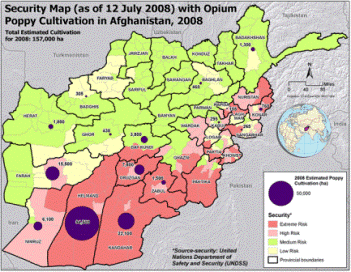In August, the UN Office on Drugs and Crime (UNODC) released its annual survey of Afghan opium production, reporting for the first time in several years a slight -- 6% -- decrease in overall production. Last Friday, the White House Office on National Drug Control Policy (ONDCP -- the drug czar's office), released its own US government estimate, claiming that production was down a whopping 31%.

"Afghanistan needs peace, a flourishing economy and the rule of law to succeed as a democracy," said drug czar John Walters as he announced the figures. "Each of these conditions is undone by narcotics production. That is why today's news is so encouraging to the people of Afghanistan. Afghanistan has been victimized for too long by the violence, misery, and addiction caused by the illegal drug trade. We look forward to continuing cooperation with the Government of Afghanistan and our allies as we work to defeat the narcotics industry and the terrorist groups that rely on the drug business to kill innocent people and attack democracy and freedom across the globe."
Despite the US report, UNODC officials in Afghanistan were sticking to their numbers. At a Kabul press conference Monday, UNODC Afghanistan head Christina Orguz said she had "high confidence" in the UNODC numbers because they were based on ground inspections, analysis of the actual opium yield of the latest crop and satellite imagery.
"Whichever figure it would turn out to be right would be a tragedy because it's still far too much produced, in any case," she said.
Both the US and the UN reported some successes in luring farmers away from the poppy crop with public information campaigns and alternative development programs. Eradication and interdiction have been less successful, but now NATO and the US have committed their forces to deeper involvement in the anti-drug effort. Still, Afghanistan remains the world's leading opium producer by far, accounting for 93% of global production.
And, if UNODC head Antonio Maria Costa is correct, Afghanistan has for the past several years produced more opium than the global illicit market can absorb. According to the UNODC, global demand for illicit opium is steady at about 4,500 tons a year, while Afghanistan has been producing considerably more for the past few years. Some 6,000 to 8,000 tons are surplus, and Costa thinks he knows where they are.
"Where is it? We have been asking," he told Time. Because of the surplus, "the prices should have collapsed," said Costa. "But there has been no price collapse."
Costa said he believed the missing opium was being stockpiled by the Taliban for lean times and as a price control mechanism. "This is classic market manipulation," he said.
So, while the US and the UN can congratulate themselves on production reductions and squabble over how big they really are, the Taliban is sitting on a gold mine of opium. At an estimated $465,000 a ton for opium, that adds up to a $3.2 billion war chest, and even a dramatic drop in production or successful eradication will not impede the Taliban's ability to wage war against the West and the government in Kabul.
This work by StoptheDrugWar.org is licensed under Creative Commons Attribution-ShareAlike 4.0 International
Add new comment